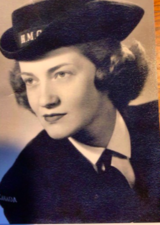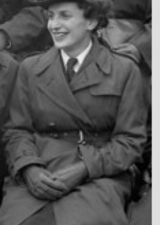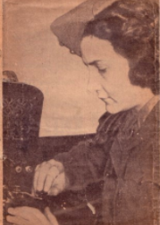Women in the Royal Canadian Navy
In 1942 the Navy welcomed female enlistees with the establishment of the Women's Royal Canadian Naval Services (WRCNS), also known as Wrens. The women filled support roles in order to free the men for active duty. From the start of World War II in 1939 to 1942, only women qualified as nurses could enlist in the navy. They served in the Royal Canadian Naval Medical Service as Nursing Sisters. The WRCNS was disbanded in 1946, re-established in 1951 and then, in 1955, women became part of the regular navy.
Featured Stories of Jewish Wrens:
Frieda Bindman (Dougherty) / Thea Schatz (Ginsburg) / Celia Weiser
Thea Schatz
Married Name: Thea Ginsburg
Birthplace: Toronto, April 26, 1919
Service Unit: Women's Royal Canadian Naval Services (WRCNS)
Rank: Leading Wren
Job: Classifier
Death Date: June 2, 2007

Image courtesy of Paul Katzeff
As a classifier, Thea's responsibilities included retrieving material from the teletype machines and delivering it to the decoding room.
After a few months in Ottawa and then Vancouver, she was posted to Bletchley Park in England. Departing from Halifax, she travelled on the MS Erria as part of a convoy that took eighteen days to reach Southhampton. At Bletchley, she was in the division that concentrated on Japanese merchant shipping, analyzing their shipping patterns. As a result of her work, she became intimately aware of many islands including Midway, Saipan and the Kuriles. In April 1945, she had the good fortune to be in the House of Lords to hear Winston Churchill deliver his eulogy for President Roosevelt.
She celebrated VE day at Oxford Circus and noted "all the subsequent pictures of the scene were not exaggerated. I frankly had some vague qualms about my safety but I managed to extricate myself." She volunteered for thirty-four months in the service.
After the war she worked as a model and a secretary. In 1947 she married Martin Ginsburg, whom she had met while she was stationed in Ottawa, and raised five children.
Sources:
Obituary. Ottawa Citizen. June 4, 2007.
Roll of Honour, Bletchley Park. (website)
Sugarman, Martin. "World War II: Jewish Personnel at Bletchley Park." Jewish Virtual Library. (website)
Torontow, Cy, Jewish War Veterans of Canada, Ottawa Post and Ottawa Jewish Historical Society. 1999. There I was… A Collection of Reminiscences by Members of the Ottawa Jewish Community Who Served in World War II. Ottawa: Jewish War Veterans of Canada, Ottawa Post.
FRIEDA BINDMAN
Married Name: Frieda Dougherty
Birthplace: Cookshire, Quebec, 1917
Service Unit: Women’s Royal Canadian Navy Service (RCNS)
Rank: Naval Officer - Lieutenant
Job: Wireless Telegraphist
Enlistment Date: December 1942
Death Date: August 28, 2009

Image from photograph of signal officers of the WRCS, 1943, Library and Archives Canada PA-142460
Born in Quebec in 1917, Frieda held a degree in French and German from McGill and was the principal of a school in Baie Comeau before enlisting in December 1942.
After training in coding, ciphering, and Morse code, Frieda was posted to Naval Service Headquarters in Ottawa. There she was responsible for ensuring smaller vessels were safe, supervising the Wrens working in the signals division and decoding any top-secret signals. On one memorable occasion she was responsible for establishing the code to warn the troopship, Queen Mary with 15,000 people aboard, that there was a German U-boat in the area. Redstone-Lewis, in her thesis on the Women's Royal Canadian Naval Service, notes from the fall of 1944 to the war's end, frequently up to five German submarines could be found off the Gulf of Maine and along the east coast of Canada as well as in the Gulf of St Lawrence. This “made acute direction bearings on the few signals broadcast by the submarines more essential than ever.”
In 1945 Frieda was transferred to Quebec City. Six months later, she was the commanding officer at the Coverdale intercept station in New Brunswick, serving there till January 1946 when responsibility for the station was relinquished to male naval officers. Her brother David was killed in Italy at the Battle of Ortona in December 1943.
After the war, Frieda returned to teaching, working at Nepean High School and Algonquin College in Ottawa. She married Tom Dougherty and became very involved in the Unitarianism. In addition to her skills as a linguist, Frieda was also a pianist.
Artwork inspired by Frieda's story.
Sources:
Ancestry.ca
"Bindman, Frieda." In Old McGill 1938 (Yearbook of McGill University). 41, p. 37. - see also page 171 for a photo of Frieda with the Germania Club.
Canadian Navy List for November 1944. Ottawa: Department of National Defence. (provides information on her rank and service locations)
Greenfeld, Nathan M. 2002. “Standing in for a Man." Maclean’s Magazine, August 26, 2002.
"In Memoriam Frieda Dougherty." Capital Carillon, November , 2009, p. 4
National Film Board. 1995. Canada Remembers, Turning the Tide 1939 - D-Day. (see 2.38 minutes for Frieda)
Obituary. Globe and Mail. September 6-9, 2009
Proc, Jerry. “Gloucester” Radio Communications and Signals Intelligence in the Royal Canadian Navy. (website)
Redstone-Lewis. Julie Anne. 2007. “The Creation of the Women’s Royal Canadian Naval Service.” MA Thesis, Wilfrid Laurier University. (includes detailed discussion of Frieda Bindman (Dougherty)’s service, see pages 89-90)
Sarah Earldine Krys in The Memory Project. Veterans Stories. Historica Canada (website) - includes a photo of Frieda along with her fellow signal officers.
WEISER, CELIA SOOKIE
Married Name: Celia Wolman
Birthplace: Toronto, November 23, 1918
Service Unit: Canadian Women's Army Corps (CWAC) / Women's Royal Canadian Navy Service (WRCNS)
Rank: Leading Wren
Job: Wireless Telegraphist
Enlistment Date: January 7, 1943 (WRCNS)
Discharge Date: August 16, 1945
Death Date: November 3, 1995

.
Photo courtesy of Celia's daughter, Sandra W. Moss
Celia Weiser is an example of how an engagement notice in the social pages of the Canadian Jewish Review provided an initial confirmation that a servicewoman was Jewish and identified her married name.
Celia had to leave school at 15 to help at her father's delicatessen. The military provided her with a way to get away from a financially challenging life and to do something for the war effort. Two of her brothers also served in the Second World War.
In January 1941, 6 months before the Army accepted women, Celia was a sergeant-major in the women's paramilitary group the Canadian Women's Service Force. Celia later enlisted in the Army and then joined the Naval Forces in 1943 and completed training as a wireless operator. Fellow Wren, Dorothy Robertson, in her memoir of her war experience, noted that Celia was the one of the first Wrens to arrive in spring 1943 to the newly established Naval Radio Station Gloucester. Officially named Number 1 Station HMCS Bytown, it was located just seventeen miles south of Ottawa, but three miles from the nearest highway. Except for three sailors assigned for maintenance duties, the rest of the personnel were female. Shortly after it was finished, the Navy discovered that the Ottawa area was not suitable for the after-midnight reception of overseas wireless signals. This resulted in the building of a new station called Coverdale, near Moncton, New Brunswick. Although many of the Wrens at Number 1 Station were transferred to Coverdale, Celia and three other Wrens volunteered to remain at Gloucester Station. Celia held overall responsibility for the direction-finding hut.
Gloucester played an important part in the war by helping Allied convoys avoid German U-boats. The key function of the station was to identify the whereabouts of German U-Boats through direction-finding equipment. The Wrens would listen for Morse code messages transmitted from the German submarines. To accomplish this, the Wrens were trained in Morse code, the call sign of the German navy's coastal stations, how to separate the traffic from U-boats from that of the shore stations, and how to use direction-finding sets.
To get to the direction-finding hut, Celia had to cross five farmers' fields and squeeze through barbed wire fences, all while carrying food, water, coal, and paper. Celia was one of a very few Jewish Wrens (between ten and fifteen have been identified so far), and at times felt that she "must be the only Jewish girl in the Navy." An athlete, Celia was a member of the Wrens of Coverdale softball team.
In the spring of 1943 Celia was engaged to Flight Lieutenant Ralph Wolman whom she had met at the Jewish Canteen in Toronto. They married in June 1945, and a few months later Celia was discharged from service. Celia and Ralph initially lived in Toronto and then settled in Florida where they raised three children. When her children were older, Celia took an insurance course. She then commenced a career selling insurance to residents of trailer parks.
Proc Jerry. "H.M.C.S. Gloucester." Radio Communications and Signals Intelligence in the Royal Canadian Navy.
Robertson, Dorothy. 2005. I Go (Not) Down to the Sea in Ships. (viewed on the CFB Esquimalt Naval and Military Museum website - see pages 43, 49-51 for mention of Celia/Sukey)
Rosenfeld, Bobbie. 1943. "Sports Reel." The Globe and Mail, August 16, 1943, 18
"Engagements." Canadian Jewish Review, April 13, 1945, 9.
"Women's War Work." Toronto Daily Star, January 15, 1941, 23
Information from Celia Weiser's daughter, Sandra W. Moss.
